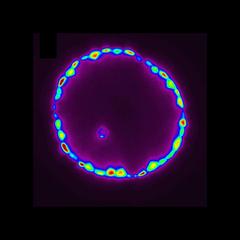URL: https://www.desy.de/news/news_search/index_eng.html
Breadcrumb Navigation
[LgDashBoard2@/e409/e116959/e119238][getObjProperty]: key=title[py] Traceback (most recent call last): File "/home/zeoclients/parts/products/zms/_objattrs.py", line 679, in getObjProperty value = metaObjAttr['py'](zmscontext=self) File "/home/zeoclients/parts/zope2/lib/python/Shared/DC/Scripts/Bindings.py", line 313, in __call__ return self._bindAndExec(args, kw, None) File "/home/zeoclients/parts/zope2/lib/python/Shared/DC/Scripts/Bindings.py", line 350, in _bindAndExec return self._exec(bound_data, args, kw) File "/home/zeoclients/parts/zope2/lib/python/Products/PythonScripts/PythonScript.py", line 328, in _exec result = f(*args, **kw) File "Script (Python)", line 6, in LgDashBoard2.title UnicodeDecodeError: 'ascii' codec can't decode byte 0xe2 in position 43: ordinal not in range(128)
News
News from the DESY research centre
Arsenic accumulates in the nuclei of plants’ cells
Toxic arsenic initially accumulates in the nuclei of plants’ cells. This has been revealed by an X-ray examination of the aquatic plant rigid hornwort (Ceratophyllum demersum) using DESY’s X-ray source PETRA III. Even at comparatively low concentrations, the arsenic also floods the vacuole, a liquid-filled cavity which takes up most of the cell. Researchers surrounding Hendrik Küpper of the Czech Academy of Sciences, who is a professor at the University of South Bohemia in Ceské Budejovice (Czech Republic), have made this discovery in the course of a project that was set up in Küpper’s group by Seema Mishra (now at the National Botanical Research Institute in Lucknow, India). The scientists report their findings in the Journal of Experimental Botany.

Distribution of arsenic within a mature leaf of rigid hornwort at a concentration of 5 micromols (375 micrograms) arsenic per litre water. Credit: Mishra et al., adapted from JExpBot Linkhttp://jxb.oxfordjournals.org/content/early/2016/06/22/jxb.erw238.abstract CC-BY-3.0 http://creativecommons.org/licenses/by/3.0/
“On top of this, humans eat plants, of course, and feed them to their livestock, so that arsenic accumulates in these and eventually ends up in human beings,” explains Küpper. “By carrying out our analysis, we wanted to find out exactly how arsenic poisoning occurs in plants,” adds co-author Gerald Falkenberg, who is in charge of the P06 beamline at DESY, where the experiments were performed. The results could help researchers to breed plants that absorb less arsenic.
According to Küpper, previous research on plants has usually been carried out with arsenic concentrations that were far too high. “Whereas concentrations of just one micromol, corresponding to 75 micrograms, per litre are already relevant in terms of plant physiology, it was not unusual to work with concentrations of up to 250 micromols per litre – concentrations at which completely different things are going on,” explains the biologist. “We wanted to know what happens at ecologically and physiologically relevant concentrations.” Up to 33 micromols arsenic per litre were reported in contaminated areas in irrigation water and soil solution.

Distribution of arsenic within leafs of rigid hornwort at concentrations of 1 micromol (75 micrograms, top) arsenic per litre water and 5 micromols (375 micrograms, bottom) arsenic per litre water. At low concentrations, arsenic accumulates predominantly in the nuclei of epidermal cells, while at high concentrations, it floods the whole cell. Credit: Mishra et al., adapted from JExpBot Linkhttp://jxb.oxfordjournals.org/content/early/2016/06/22/jxb.erw238.abstract CC-BY-3.0 http://creativecommons.org/licenses/by/3.0/
A concentration of one micromol of arsenic per litre of water is still tolerated by the plant. The plant first deposits the toxin in its outer layer, the epidermis. “Surprisingly enough, we found that arsenic initially accumulates in the cell nuclei,” Küpper reports. Only when the concentration rises to five micromols per litre, a level that the plants are unable to withstand for prolonged periods, is arsenic also found in the vacuole and thus more or less throughout the entire cell.
“This means that the capacity of the epidermis is exhausted and the plant can no longer get rid of the toxin, and that’s when things start to get serious,” says Küpper. The arsenic now spreads to the so-called mesophyll, which makes up most of the leaf. This is where photosynthesis takes place, in other words where the plant absorbs light and produces sugars. This shift in the distribution can be clearly observed in the X-ray tomogram of the leaves.
The investigation showed that arsenic damages the enzymes that are responsible for producing chlorophyll, the green pigment required for photosynthesis. Arsenic first inhibits photosynthesis, which is not due to the removal of chlorophyll but rather to the reduced production of the pigment, as Küpper points out.
In future studies, the scientists are hoping to find out what arsenic does inside the cell nucleus. “Presumably, it causes genetic damage,” says Küpper. For example, arsenic might replace the phosphorus in the genes. Whereas the current X-ray examination shows that arsenic already accumulates in the cells’ nuclei at low concentrations, the scientists are planning further experiments in which they will look at the chemical bonds that are formed by arsenic in the nucleus as compared with other parts of the cell.
Reference:
Analysis of sub-lethal arsenic toxicity to Ceratophyllum demersum: Subcellular distribution of arsenic and inhibition of chlorophyll biosynthesis; Seema Mishra, Matthias Alfeld, Roman Sobotka, Elisa Andresen, Gerald Falkenberg, Hendrik Küpper; Journal of Experimental Botany, 2016; DOI: 10.1093/jxb/erw238




